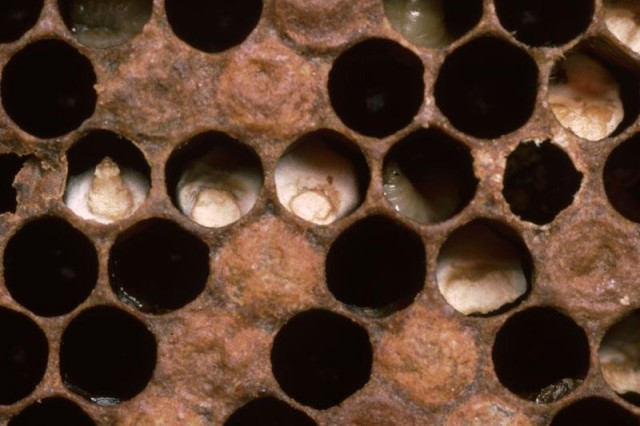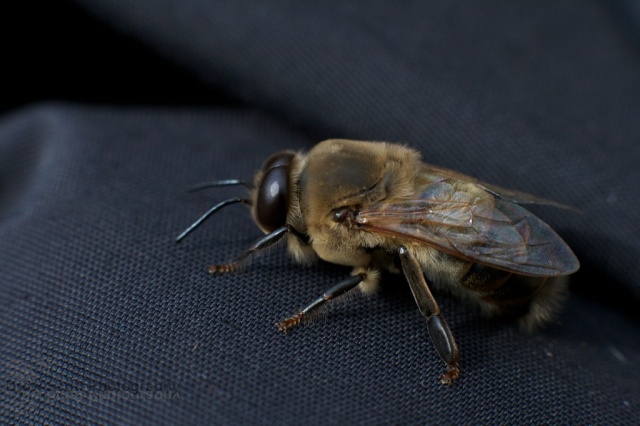A 9th revision post for the British Beekeeping Association’s Module 3 Honey bee Pests, Diseases and Poisoning exam, which I’m taking in March. I’m doing the BBKA’s correspondence course, so my tutor, Pam Hunter, sets me papers which she then marks. The second question of Paper 3 is all about chilling, very appropriate as it’s mighty bitter out there just now…
B2. a) discuss the possible causes of chilled brood
- A lack of bees
Any factor which reduces the number of bees in a colony below the minimum needed to look after the brood will cause chilling; this could include poisoning, loss of a large swarm, a rapidly growing colony during spring or plain old beekeeper cock-ups. The effects can be seen when large areas of brood fail to develop, whereas disease usually causes a pepperpot effect with some larvae emerging and others failing.
The bottom and sides of brood frames are most likely to contain chilled brood, and it is most likely to be seen in early spring, when the temperature may drop after a warm spell which encouraged the queen to lay well. Dead brood can first appear a yellowy grey colour, before turning dark brown or black, then finally drying out to removable black remains. Nurse bees will abandon the frames on the outside of the brood nest first and try to preserve the larvae in the warmer centre.
- Beekeeper mishandling
Don’t try to make up nucleuses or hives with an imbalance in the ratio of brood to adult bees; make sure there are plenty of bees to look after the brood. The BBKA has produced Nucleus guidelines which recommend that “Brood and eggs in all stages should occupy at least half the total comb area, with no brood cycle break…There should be a good balance of young and flying bees, and the frames should be well covered.”
A well-meaning beekeeper trying to speed up the colony’s growth by ‘spreading’ or moving about the brood frames by putting extra frames of foundation between brood frames can cause chilling. Do not be tempted to mess with the brood nest!
Long inspections in chilly weather should be avoided. However, bear in mind that young larvae can survive for several hours at well below normal brood nest temperature (35C/95F). Chilled brood is caused by prolonged exposure to cold temperatures and/or starvation due to neglect by the adult and nurse bees in the colony – not beekeeper inspections. But leaving the brood box open for several minutes in cold weather isn’t going to help or endear you to the bees.
To help the bees in keeping the brood warm, try not to give them too much space whilst the colony is building up in spring, particularly if you are filling in the brood box with empty frames of foundation. If you have a small colony in a ten frame brood box but they are only on four frames, the sixth frame down can be replaced with a solid wooden ‘dummy board’, to help keep warmth in. The dummy board can then gradually be moved out as the colony occupies more frames.
b) short periods of chilling can make brood susceptible to another brood disease; name the disease and its causative organism
Chalkbrood is an extremely common brood disease which is often present at low levels in colonies. It is thought to become a noticeable problem when the colony is weak and when levels of carbon dioxide rise above normal, because the bees are failing to maintain the correct conditions in the hive. It is also linked to stresses such as insufficient nurse bees, pollen shortage and the presence of sac brood.
Chalk brood is caused by a fungus named Ascosphaera apis. This delightful organism begins to germinate when a larva takes in its spores with its food. Inside the gut, the spores start to grow, producing multiple branches of fine cotton-like threads. These break through the gut wall and continue to grow throughout the body of the poor larva, until eventually it becomes “a swollen mass of fluffy white fungus with a small yellow lump where its head used to be“, as Celia Davis puts it in her excellent book ‘The Honey Bee Around & About’ (2007).
The infected larva dries to a hard chalk-like lump called a ‘mummy’, which can be white, grey or black. These will rattle when the comb is shaken. Death occurs after the cells have been sealed, so workers will tear the cappings open to remove the mummies and dispose of them outside the hive. Unfortunately the mummy spores are sticky and will attach to the bees, causing them to infect larvae when they re-enter the hive. Yet another reason to change brood comb regularly – the spores are resistant to heat and have a life of between 3-38 years.

Chalk brood mummies on a hive floor. Courtesy The Food and Environment Research Agency (Fera), Crown Copyright.
Like chilled brood, beekeepers are most likely to see chalk brood in the spring when colonies are expanding the brood nest rapidly, but do not yet have a large adult bee population. Even if the resulting chilling is not sufficient to kill the larvae, it seems to encourage the growth of the Ascosphaera fungus.
c) what are the causes of neglected drone brood?
Drones are more dispensable than workers. They eat lots, do no work and generally slob about the hive. Their bulk can be useful in keeping the brood warm, but still they are less than essential for the individual colony to survive.
So drone brood is usually the first to be neglected and ignored if a colony is under pressure, for instance if little forage is available or long periods of bad weather stop the bees foraging. The sisters may then unceremoniously ditch their brothers to ensure the colony’s survival, often throwing the drone larvae out of the hive.
In the case of a drone-laying queen or laying workers, no new nurse bees are being produced, so the increasingly old workers are unable to keep up with feeding all the drone larvae.
References:
- The BBKA Guide to Beekeeping, Ivor Davis & Roger Cullum-Kenyon (2012)
- Bee diseases and their management: Chilled brood, Edinburgh & Midlothian Beekeepers’ Association (2009)
- The Honey Bee Around & About, Celia Davis, Bee Craft Ltd (2007), p54-56
- Mid Bucks Beekeepers Association, Module 3 exam notes
- National Bee Unit ‘Foul Brood Disease of Honey Bees and other common brood disorders’ advisory leaflet




To stop chilling is there a method to add warmth to a hive through artificial means?
LikeLike
Hi Alex, not that I know of, except that beekeepers will insulate the hive during winter. I haven’t come across any sophisticated equipment that keeps the brood box at a steady temperature. Even if such equipment did exist, it wouldn’t solve the problem completely, as a lack of nurse bees also means the larvae will not be fed properly and are likely to starve or not develop fully. Beekeepers have no way of producing brood food themselves, so nurse bees are essential.
LikeLike
Ah ha! This new beekeeping product just sent by Andy for the next newsletter is designed to keep bees snug in winter and cold periods. Not sure of efficacy, or other considerations like condensation, but looks cute! http://www.beesnug.co.uk/
LikeLike
I saw that advertised on the BBKA’s Facebook page… there were a lot of sceptics but then there always are!
LikeLike
It could be a gimmick and, of course, as we know beekeepers like to ‘make’ everything themselves! 😉
LikeLike
Do you insulate the hives if it goes below zero, say?
LikeLike
Around November time Emma and I prepared the hives for winter by putting polystyrene insulation at the top of the hive. Chilled brood is not such a problem in winter though, as then the amount of brood is very small or non-existent – at the moment the brood nest area is probably the size of the palm of your hand. The difficult time comes in spring, when the temperatures are higher but a relatively small number of adult bees are trying to look after the larvae as the queen’s laying picks up.
LikeLike
I understand better now. I can see that in spring the bees will have more to do and cannot protect the larvae if there was a sudden fall in temperature.
LikeLike
That’s it. In early spring a lot of the adult bees will be bees born in the autumn that have overwintered and are coming to the end of their lifespan, so they are getting worn out by then.
LikeLike
We had chalk brood but at the end of July the summer before last. This was after a period of constant rain and cool temperatures. I was a little freaked at first, but the bee inspector (for of course he was the one who identified it) said we should just keep an eye on it and that it would most likely resolve itself. It was only a very little bit, though. Learning lots from the posts!
LikeLike
Our bee inspector found it in one of our hives too, during 2012’s wet spring. Now that I know a bit more about it hopefully I’ll spot it more easily.
LikeLike
A very informative blog Emily. About all the problems bees, and others, can have; I do think we interfere too much, and there are too many of ‘us’.
LikeLike
Thanks Mark. Too many humans? I would tend to agree with that. Living in London makes me very aware of just how squashed and cramped we are becoming, and how little space nature has left.
LikeLike
Pingback: June arrives bringing warmer weather but also swarms galore | Tales from the beehive - a beekeepers blog
“Not particularly useful” reference to Drones…WELL WITHOUT DRONES THERE WOULDN’T BE ANY BEES..Not particularly useful ,how about bees all have important roles and the Drones job comes as possibly the MOST IMPORTANT.
LikeLike
This is a post about how worker bees and the colony as a whole treats drones. As a beekeeper I am gentle with the drones and very much on their side.
Cape honey bee workers can produce female daughters without mating but other honey bee species haven’t gone down this route, so yes drones are still needed.
LikeLike